Blue–Green Infrastructure Network Planning in Urban Small Watersheds Based on Water Balance
Abstract
1. Introduction
2. Case Study
2.1. Overview of the Study Area
2.2. Current Challenges
2.2.1. Water Balance Issues in the Watershed
2.2.2. Limitations of High-Density Development on BGI Network
2.3. Data Sources
3. Methods
- The Soil Conservation Service Curve Number (SCS–CN) model was used to estimate the maximum potential of natural recharge from a small watershed, thereby demonstrating the hydrological value of natural runoff.
- A network optimization model was constructed. First, the new river layout was determined using landscape connectivity indices, the Cumulative Resistance (MCR) model, and a gravity model. Second, a set of optimization constraints was analyzed, including (i) limitations on the water surface ratio; (ii) ensuring that newly added rivers do not cause flooding under a 20-year return period rainfall event; (iii) restricting the inflow velocity at lake inlets to not exceed the outflow velocity at the drainage outlet of Xuanwu Lake; and (iv) reducing flood risks in identified hotspot areas. To meet these constraints, the scale and spatial configuration of green spaces should be aligned with the blue network, ultimately forming a primary blue–green corridor system. Additionally, efforts are made to establish secondary green infiltration corridors that link decentralized Blue–Green Infrastructure (BGI) elements. This optimization process achieves a balance between enhanced hydrological connectivity and regional flood resilience.
- A water balance model was developed by integrating empirical formulas with the Storm Water Management Model (SWMM) and was coupled with the network optimization model. The net water budget of the lake was calculated to evaluate the reduction in artificial water supplementation. The flood mitigation benefits of the BGI network were quantified based on runoff reduction within the watershed and its sub-catchments.
- Based on insights drawn from past practices, this study proposes future blue–green spatial development strategies for urban planning.
3.1. SCS-CN Model
3.1.1. SCS-CN Model Formula
3.1.2. Hydrologic Soil Groups and Land Use Types
3.1.3. Antecedent Moisture Condition (AMC) and Slope Adjustment
3.1.4. Determination of CN Values
3.1.5. Calculation of Surface Runoff Volume
3.2. BGI Network Optimization Model
3.2.1. Overall Framework of Network Optimization
- Constraints on Newly Added Water Bodies: According to urban water surface ratio control requirements, the total area of newly added water bodies should be limited to no more than 150,000 m2.
- Urban Drainage Standards for River Channels: River channels in the main urban area must be designed to withstand a storm event with a 20-year return period (with a duration of 120 min). Additionally, water levels should quickly return to operational levels after rainfall ceases to avoid surface flooding caused by river overtopping. All newly designed river channels must strictly adhere to this standard. This study employed the Chicago rainfall pattern generator to produce a 2 h rainfall hyetograph corresponding to a 20-year return period, based on the storm intensity formula officially released by the Nanjing Water Authority in 2024. The formula and detailed rainfall data are provided in Appendix A.1. The selection of a 120 min, 20-year return period rainfall event is in accordance with the requirements outlined in the Comprehensive Drainage and Flood Control Planning for the Central Urban Area of Nanjing City.
- Balance of Lake Carrying Capacity: Under a storm event with a 100-year return period, the inflow rate into Xuanwu Lake from newly introduced runoff must match the lake’s existing outflow capacity. Excessively rapid inflow could raise the lake’s water level, expand inundation areas, and increase flood risks.
- Localized Flood Mitigation in Source Areas: Driven by urban spatial safety policies, current planning encourages the installation of small- and medium-scale water retention facilities in flood-prone areas within high-density built-up zones. Although limited in size, such facilities play a critical role in alleviating local pluvial flooding. In this study, a secondary corridor system composed of green belts and infiltration trenches is developed to improve connectivity between dispersed retention facilities and the main river corridors, thereby enhancing flood resilience in source areas.
3.2.2. Optimization of Primary Corridors
- Landscape Connectivity Index Analysis
- Construction of the MCR Model
- Gravity model
3.2.3. Synergistic Planning of Waterfront Green Spaces
3.2.4. Optimization of Secondary Corridors
3.3. Calculation Model of Water Balance
3.3.1. SWMM
3.3.2. Empirical Formula for Water Balance
- Monthly precipitation:
- Monthly water surface evaporation:
- Monthly seepage through the lakebed [67]:
- Monthly artificial water supplementation:
- Monthly water level adjustment:
- Monthly inflow discharge into the lake:
- Monthly outflow discharge from the lake:
- The reduction in monthly artificial water supplementation in the future:
4. Results
4.1. Simulation of Network Optimization Scheme
4.2. Water Balance of Lake
5. Discussion
5.1. Management and Implementation
Build a Water Balance Regulation System
5.2. Differences from Existing BGI Network Optimization Studies
5.3. Research Value
5.4. Limitations and Future Research Directions
6. Conclusions
Author Contributions
Funding
Data Availability Statement
Acknowledgments
Conflicts of Interest
Appendix A
Appendix A.1

Appendix A.2
| Elevation | Slope | Land Cover | Distance to Rivers | Weight (Value) | |
|---|---|---|---|---|---|
| Elevation | 1 | 1 | 2 | 3 | 34% |
| Slope | 1 | 1 | 2 | 2 | 31% |
| Land cover | 1/2 | 1/2 | 1 | 2 | 21% |
| Distance to rivers | 1/3 | 1/2 | 1/2 | 1 | 14% |
Appendix A.3
| (a) | ||
| Parameter | Indicators | Parameters |
| Surface Layer Properties | Berm Height (or Storage Depth) | 200 |
| Vegetative Volume Fraction | 0.15 | |
| Surface Roughness | 0.1 | |
| Surface Slope | 2 | |
| Storage Layer Properties | Thickness | 600 |
| Void Ratio | 0.45 | |
| Seepage Rate | 7 | |
| Clogging Factor | 0 | |
| Drainage Layer Properties | Drain Coefficient | 25 |
| Drain Exponent | 0.5 | |
| Drain Offset Height | 50 | |
| (b) | ||
| Parameter | Indicators | Parameters |
| Surface Layer Properties | Berm Height (or Storage Depth) | 200 |
| Vegetative Volume Fraction | 0.15 | |
| Surface Roughness | 0.1 | |
| Surface Slope | 2 | |
| Swale Side Slope | 4 | |
| (c) | ||
| Parameter | Indicators | Parameters |
| Surface Layer Properties | Berm Height (or Storage Depth) | 100 |
| Vegetative Volume Fraction | 0.2 | |
| Surface Roughness | 0.2 | |
| Surface Slope | 2 | |
| Storage Layer Properties | Thickness | 250 |
| Void Ratio | 0.35 | |
| Seepage Rate | 10 | |
| Clogging Factor | 0.1 | |
| Soil Properties | Thickness | 450 |
| Porosity | 0.5 | |
| Field Capacity | 0.2 | |
| Wilting Point | 0.1 | |
| Conductivity | 20 | |
| Conductivity Slope | 3.5 | |
References
- Adhikari, U.; Broekhuizen, I.; Pons, V.; Sun, Z.; Sjöman, J.D.; Randrup, T.B.; Viklander, M.; Blecken, G.-T. Comparing the hydrological performance of blue green infrastructure design strategies in urban/semi-urban catchments for stormwater management. Water Sci. Technol. 2024, 90, 2696–2712. [Google Scholar] [CrossRef]
- Alamdari, N.; Hogue, T.S. Assessing the effects of climate change on urban watersheds: A review and call for future research. Environ. Rev. 2022, 30, 61–71. [Google Scholar] [CrossRef]
- Battemarco, B.P.; Tardin-Coelho, R.; Veról, A.P.; de Sousa, M.M.; da Fontoura, C.V.T.; Figueiredo-Cunha, J.; Barbedo, J.M.R.; Miguez, M.G. Water dynamics and blue-green infrastructure (BGI): Towards risk management and strategic spatial planning guidelines. J. Clean. Prod. 2022, 333, 129993. [Google Scholar] [CrossRef]
- UN Water (Ed.) The United Nations World Water Development Report: Valuing Water; UNESCO: Paris, France, 2021. [Google Scholar]
- Cavadini, G.B.; Rodriguez, M.; Cook, L.M. Connecting blue-green infrastructure elements to reduce combined sewer overflows. J. Environ. Manag. 2024, 365, 121465. [Google Scholar] [CrossRef]
- Chen, J.; Ji, J.; Wang, H.; Deng, M.; Yu, C. Risk Assessment of Urban Rainstorm Disaster Based on Multi-Layer Weighted Principal Component Analysis: A Case Study of Nanjing, China. Int. J. Environ. Res. Public Health 2020, 17, 5523. [Google Scholar] [CrossRef]
- Brody, S.D.; Highfield, W.E.; Blessing, R.; Makino, T.; Shepard, C.C. Evaluating the effects of open space configurations in reducing flood damage along the Gulf of Mexico coast. Landsc. Urban Plan. 2017, 167, 225–231. [Google Scholar] [CrossRef]
- Christenson, E.; Elliott, M.; Banerjee, O.; Hamrick, L.; Bartram, J. Climate-Related Hazards: A Method for Global Assessment of Urban and Rural Population Exposure to Cyclones, Droughts, and Floods. Int. J. Environ. Res. Public Health 2014, 11, 2169–2192. [Google Scholar] [CrossRef]
- Cavadini, G.B.; Rodriguez, M.; Nguyen, T.; Cook, L.M. Can blue–green infrastructure counteract the effects of climate change on combined sewer overflows? Study of a swiss catchment. Environ. Res. Lett. 2024, 19, 094025. [Google Scholar] [CrossRef]
- Chen, W.; Wang, W.; Huang, G.; Wang, Z.; Lai, C.; Yang, Z. The capacity of grey infrastructure in urban flood management: A comprehensive analysis of grey infrastructure and the green-grey approach. Int. J. Disaster Risk Reduct. 2021, 54, 102045. [Google Scholar] [CrossRef]
- Wang, Z.; Li, Z.; Liu, C.; Li, Y.; Liu, X.; Hao, X. Discussion on Water Cycle Mechanism of Interconnected River System Network. J. Nat. Resour. 2011, 26, 523–529. [Google Scholar]
- Ahmed, S.; Meenar, M.; Alam, A. Designing a Blue-Green Infrastructure (BGI) Network: Toward Water-Sensitive Urban Growth Planning in Dhaka, Bangladesh. Land 2019, 8, 138. [Google Scholar] [CrossRef]
- Almaaitah, T.; Appleby, M.; Rosenblat, H.; Drake, J.; Joksimovic, D. The potential of Blue-Green infrastructure as a climate change adaptation strategy: A systematic literature review. Blue-Green Syst. 2021, 3, 223–248. [Google Scholar] [CrossRef]
- European Commission. Green Infrastructure (GI)—Enhancing Europe’s Natural Capital; European Commission: Brussels, Belgium, 2013. [Google Scholar]
- Hamel, P.; Tan, L. Blue–Green Infrastructure for Flood and Water Quality Management in Southeast Asia: Evidence and Knowledge Gaps. Environ. Manag. 2022, 69, 699–718. [Google Scholar] [CrossRef]
- Zannat, E.U.; Dedekorkut-Howes, A.; Morgan, E.A. A review of nature-based infrastructures and their effectiveness for urban flood risk mitigation. WIREs Clim. Change 2024, 15, e889. [Google Scholar] [CrossRef]
- Gu, J.; Lyu, X.; Fang, B.; Hui, Q.; Cao, Y. Study on Planning and Design of Blue-Green-Gray Transformation of Lakeside Cities to Deal with the Complex Urban Waterlogging Caused by Extreme Rainstorm. Land 2023, 12, 289. [Google Scholar] [CrossRef]
- Luo, Z.; Tian, J.; Zeng, J.; Pilla, F. Resilient landscape pattern for reducing coastal flood susceptibility. Sci. Total Environ. 2023, 856, 159087. [Google Scholar] [CrossRef]
- Mugume, S.N.; Kibibi, H.; Sorensen, J.; Butler, D. Can Blue-Green Infrastructure enhance resilience in urban drainage systems during failure conditions? Water Sci. Technol. 2024, 89, 915–944. [Google Scholar] [CrossRef]
- Tansar, H.; Duan, H.F.; Mark, O. Catchment-scale and local-scale based evaluation of LID effectiveness on urban drainage system performance. Water Resour. Manag. 2022, 36, 507–526. [Google Scholar] [CrossRef]
- Meng, L.Y.; Tian, Z.; Fan, D.L.; van de Ven, F.H.M.; Sun, L.; Ye, Q.H.; Sun, S.X.; Liu, J.G.; Nougues, L.; Rooze, D. A multi-objective optimization approach for harnessing rainwater in changing climate. Adv. Clim. Change Res. 2024, 15, 976–987. [Google Scholar] [CrossRef]
- Zhou, Q. A Review of Sustainable Urban Drainage Systems Considering the Climate Change and Urbanization Impacts. Water 2014, 6, 976–992. [Google Scholar] [CrossRef]
- Wang, D.; Liu, C.; Guo, Y.; Tang, P.; Jiao, J.; Kong, W.; Zhang, L.; Liu, Y.; Kong, D. Research strategy for constructing a green infrastructure network based on spatial prioritization. Ecosyst. Health Sustain. 2022, 8, 2088403. [Google Scholar] [CrossRef]
- Hysa, A. Introducing Transversal Connectivity Index (TCI) as a method to evaluate the effectiveness of the blue-green infrastructure at metropolitan scale. Ecol. Indic. 2021, 124, 107432. [Google Scholar] [CrossRef]
- Yang, Z.; Feng, M.Q. Research on the Water System Connectivity Scheme of Urban Artificial Shallow Lake Groups. Yangtze River 2020, 51, 49–58. [Google Scholar]
- Geng, J.Y. Research on the Restoration of the Xuanwu Lake Watershed Water System Combined with Green Space Layout; Southeast University: Nangjing, China, 2020. [Google Scholar]
- Liu, Y.; Zhai, Y.; Cui, B. Hydrological connectivity for synergism between environmental flow and water quality in urban river-lake system. J. Environ. Manag. 2025, 381, 125300. [Google Scholar] [CrossRef]
- Li, Y.; Zhang, Q.; Yao, J.; Tan, Z.; Liu, X. Assessment of water storage response to surface hydrological connectivity in a large floodplain system (Poyang Lake, China) using hydrodynamic and geostatistical analysis. Stoch. Environ. Res. Risk Assess. 2019, 33, 2071–2088. [Google Scholar] [CrossRef]
- Zhang, Z.; Huang, Y.; Xu, C.-Y.; Chen, X.; Moss, E.M.; Jin, Q.; Bailey, A.M. Analysis of Poyang Lake water balance and its indication of river–lake interaction. SpringerPlus 2016, 5, 1555. [Google Scholar] [CrossRef] [PubMed]
- Zhao, W.; Yang, R.; Wang, Q. Multi-Scale Collaborative Planning Path and Methods of Blue-Green Space for Hilly Cities: Taking Ziyang City as an Example. J. Hum. Settl. West China 2023, 38, 31–39. [Google Scholar]
- Zhu, Y.; Chen, Y.; Ma, Y.; Xu, E.; Zhang, S.; Zhang, Y.; Tian, G.H. Construction of blue-green infrastructure network in Dengfeng City under flooding risk stress. J. China Agric. Univ. 2023, 28, 175–188. [Google Scholar]
- Molné, F.; Donati, G.F.; Bolliger, J.; Fischer, M.; Maurer, M.; Bach, P.M. Supporting the planning of urban blue-green infrastructure for biodiversity: A multi-scale prioritisation framework. J. Environ. Manag. 2023, 342, 118069. [Google Scholar] [CrossRef]
- Kaur, R.; Gupta, K. Blue-Green Infrastructure (BGI) network in urban areas for sustainable storm water management: A geospatial approach. City Environ. Interact. 2022, 16, 100087. [Google Scholar] [CrossRef]
- Herath, P.; Bai, X. Benefits and co-benefits of urban green infrastructure for sustainable cities: Six current and emerging themes. Sustain. Sci. 2024, 19, 1039–1063. [Google Scholar] [CrossRef]
- Dai, W.; Liu, B.X. Research on the Application of NbS in Urban Rainstorm Flood Resilience Planning. Chin. Landsc. Archit 2023, 39, 53–58. [Google Scholar] [CrossRef]
- Sehrawat, S.; Shekhar, S. Potential sites for blue-green infrastructure in Gurugram, India; a multicriteria analysis. GeoJournal 2024, 89, 36. [Google Scholar] [CrossRef]
- Harlis, T.A.; Seo, S.B. Land suitability analysis for blue-green infrastructure implementation in an urban stormwater management system in Surabaya, Indonesia. Water Sci. Technol. 2024, 90, 1501–1519. [Google Scholar] [CrossRef]
- Xing, W.; Xu, W.; Wang, K.; Yan, X. Risk analysis of hydrological failures of levees in external Qinhuai River. J. Hohai Univ. Nat. Sci. 2006, 34, 262–266. [Google Scholar]
- Ye, C.; Xu, Z.; Lei, X.; Zhang, R.; Chu, Q.; Li, P.; Ban, C. Assessment of the impact of urban water system scheduling on urban flooding by using coupled hydrological and hydrodynamic model in Fuzhou City, China. J. Environ. Manag. 2022, 321, 115935. [Google Scholar] [CrossRef] [PubMed]
- Zhu, L.; Gao, C.; Wu, M.; Zhu, R. Integrating Blue–Green Infrastructure with Gray Infrastructure for Climate-Resilient Surface Water Flood Management in the Plain River Networks. Land 2025, 14, 634. [Google Scholar] [CrossRef]
- Zhou, M.; He, Y.; Qiu, Z. Construction of a Multi-level Blue-Green Infrastructure Network in a Riverside City: A Case Study of Shaoxing. Ecosyst. Health Sustain. 2025, 11, 0287. [Google Scholar] [CrossRef]
- Azis, S.S.A.; Zulkifli, N.A.A. Green roof for sustainable urban flash flood control via cost benefit approach for local authority. Urban For. Urban Green. 2021, 57, 126876. [Google Scholar] [CrossRef]
- Zhai, J.; Kong, H.; Xiao, H.; Yu, Q. Water Quantity Design of Urban Artificial Landscape Lake. China Water Wastewater 2012, 28, 55–56,58. [Google Scholar]
- Wu, J.; Lin, H.; Ji, H.; Wu, Z.; Jin, S. Calculation of water quantity entering the Taihu Lake from the Huxi sub-basin during flood season under the background of urbanization. Adv. Water Sci. 2021, 32, 577–586. [Google Scholar]
- Yu, M.; Zhang, H. Suitable water level for landscape function of lakes in southern plains of China based on optimization of comprehensive benefits. J. Hohai Univ. Nat. Sci. 2015, 43, 222–229. [Google Scholar]
- Xu, W.; Cao, S. Calculation method of eco-environmental water demand of urban lake with an example of Dongchang lake in Liaocheng city of China. J. Hydroelectr. Eng. 2009, 28, 102–107. [Google Scholar]
- Li, X.N.; Zhang, S.Y.; Zhu, G.E. Research and Practice on the Technology of Urban River-Lake Connectivity and Water Environment Remediation: A Case Study of Jinji Lake and Its Surrounding River Network. Yangtze River 2021, 52, 31–37. [Google Scholar]
- Wang, Z.J.; Li, C.Y.; Li, W.P.; Zhang, S. Calculation and Analysis of Water Balance of Hulun Lake in Inner Mongolia. Lake Sci. 2012, 24, 273–281. [Google Scholar]
- Zhang, S.H.; Chen, Z.Q. Research on the Design of Water Replenishment Scheme for an Artificial Lake in a Certain City. Water Supply Drain. 2023, 59, 605–609. [Google Scholar]
- Granados Aragonez, R.A.; Martinez Duran, A.; Martin, X. Green Infrastructure for Reintegrating Fragmented Urban Fabrics: Multiscale Methodology Using Space Syntax and Hydrologic Modeling. Urban Sci. 2025, 9, 208. [Google Scholar] [CrossRef]
- Sinder, D. Chapter 16 Hydrographs. In National Engineering Handbook; United States Department of Agriculture Soil Conservation Service: Washington, DC, USA, 1972; Section 4: Hydrology; pp. 16.1–16.24. [Google Scholar]
- Huang, M.; Gallichand, J.; Wang, Z.; Goulet, M. A modification to the Soil Conservation Service curve number method for steep slopes in the Loess Plateau of China. Hydrol. Process. 2006, 20, 579–589. [Google Scholar] [CrossRef]
- Lian, H.; Yen, H.; Huang, J.-C.; Feng, Q.; Qin, L.; Bashir, M.A.; Wu, S.; Zhu, A.-X.; Luo, J.; Di, H.; et al. CN-China: Revised runoff curve number by using rainfall-runoff events data in China. Water Res. 2020, 177, 115767. [Google Scholar] [CrossRef] [PubMed]
- Ma, L.; Wang, C.; Wang, W.; Zhang, L.; Huang, H.; Zhang, S. Regional Runoff Characteristics in Zhengzhou City Based on SCS-CN Model. Bull. Soil Water Conserv. 2022, 42, 203–209. [Google Scholar]
- Wang, M.; Zhao, Y.; Shi, W.; Yu, J.; Chen, T.; Bao, J.; Song, W.; Chen, H. A modified curve number method for runoff prediction of different soil types in China. CATENA 2025, 254, 108957. [Google Scholar] [CrossRef]
- Saura, S.; Pascual-Hortal, L. A new habitat availability index to integrate connectivity in landscape conservation planning: Comparison with existing indices and application to a case study. Landsc. Urban Plan. 2007, 83, 91–103. [Google Scholar] [CrossRef]
- Saura, S.; Rubio, L. A common currency for the different ways in which patches and links can contribute to habitat availability and connectivity in the landscape. Ecography 2010, 33, 523–537. [Google Scholar] [CrossRef]
- Saaty, T.L. A scaling method for priorities in hierarchical structures. J. Math. Psychol. 1977, 15, 234–281. [Google Scholar] [CrossRef]
- Wedley, W.C. Consistency prediction for incomplete AHP matrices. Math. Comput. Model. 1993, 17, 151–161. [Google Scholar] [CrossRef]
- Chen, H.; Liu, Y.; Hu, L.; Zhang, Z.; Chen, Y.; Tan, Y.; Han, Y. Constructing a Flood-Adaptive Ecological Security Pattern from the Perspective of Ecological Resilience: A Case Study of the Main Urban Area in Wuhan. Int. J. Environ. Res. Public Health 2023, 20, 385. [Google Scholar] [CrossRef]
- Cheng, Y.; Wang, X. Ecological Logic of Urban Blue-green Space Integration Planning. Chin. Landsc. Archit. 2023, 39, 39–43. [Google Scholar]
- Jiao, X.; Zhang, Y.; Liu, X.; Lu, X.; Zhao, Z. Construction and Integration Evaluation of Blue-green Space Index System of Typical Rivers and Lakes in Shanghai. Resour. Environ. Yangtze Basin 2023, 32, 995–1004. [Google Scholar]
- Jiao, X.; Zhao, Z.; Li, X.; Wang, Z.; Zhang, Y. Advances in the blue-green space evaluation index system. Ecohydrology 2023, 16. [Google Scholar] [CrossRef]
- Wang, X.-J.; Wei, X.; Chen, X. Morphological Suitability Analysis of Urban Greenspaces with Rivers: A Case Study of the Lixiahe Riverine Area. Sustainability 2022, 14, 13266. [Google Scholar] [CrossRef]
- Khatooni, K.; Hooshyaripor, F.; MalekMohammadi, B.; Noori, R. A new approach for urban flood risk assessment using coupled SWMM–HEC-RAS-2D model. J. Environ. Manag. 2025, 374, 123849. [Google Scholar] [CrossRef]
- Pushpalatha, R.; Perrin, C.; Le Moine, N.; Andréassian, V. A review of efficiency criteria suitable for evaluating low-flow simulations. J. Hydrol. 2012, 420, 171–182. [Google Scholar] [CrossRef]
- Chen, F.R.; Yan, C.T. Discussion on the Waterproofing System of Xuanwu Lake Tunnel in Nanjing. Tunn. Constr. 2005, 5, 4–5. [Google Scholar]
- Sun, Z.Y.; Jiang, C.L. Research on the Ecological Water Level of Xuanwu Lake Based on Aquatic Plant Restoration. Adv. Sci. Technol. Water Resour. 2023, 43, 49–54+76. [Google Scholar]
- Chiew, F.H.S.; Zhou, S.L.; McMahon, T.A. Use of seasonal streamflow forecasts in water resources management. J. Hydrol. 2003, 270, 135–144. [Google Scholar] [CrossRef]
- Raimondi, A.; Quinn, R.; Abhijith, G.R.; Becciu, G.; Ostfeld, A. Rainwater Harvesting and Treatment: State of the Art and Perspectives. Water 2023, 15, 1518. [Google Scholar] [CrossRef]
- Chen, X.; Xu, L.; Zhu, R.; Ma, Q.; Shi, Y.; Lu, Z. Changes and Characteristics of Green Infrastructure Network Based on Spatio-Temporal Priority. Land 2022, 11, 901. [Google Scholar] [CrossRef]
- Liu, Y.; Huang, T.-T.; Zheng, X. A method of linking functional and structural connectivity analysis in urban green infrastructure network construction. Urban Ecosyst. 2022, 25, 909–925. [Google Scholar] [CrossRef]
- Wang, S.; Wu, M.; Hu, M.; Fan, C.; Wang, T.; Xia, B. Promoting landscape connectivity of highly urbanized area: An ecological network approach. Ecol. Indic. 2021, 125, 107487. [Google Scholar] [CrossRef]
- Geng, J.; Yu, K.; Sun, M.; Xie, Z.; Huang, R.; Wang, Y.; Zhao, Q.; Liu, J. Construction and Optimisation of Ecological Networks in High-Density Central Urban Areas: The Case of Fuzhou City, China. Remote Sens. 2023, 15, 5666. [Google Scholar] [CrossRef]
- Shi, X.; Qin, M.; Li, B.; Zhang, D. A Framework for Optimizing Green Infrastructure Networks Based on Landscape Connectivity and Ecosystem Services. Sustainability 2021, 13, 10053. [Google Scholar] [CrossRef]
- Chen, X.; Davitt-Liu, I.; Erickson, A.J.; Feng, X. Integrating the Spatial Configurations of Green and Gray Infrastructure in Urban Stormwater Networks. Water Resour. Res. 2023, 59, e2023WR034796. [Google Scholar] [CrossRef]
- Lim, T.C.; Welty, C. Effects of spatial configuration of imperviousness and green infrastructure networks on hydrologic response in a residential sewershed. Water Resour. Res. 2017, 53, 8084–8104. [Google Scholar] [CrossRef]
- Hu, G.; Zhang, Y.; Chen, C.; Shen, Z.; Hu, Y.; Yin, H.; Shao, Z.; Zheng, H.; Chen, F. Exploring the decentralized blue-green infrastructure network layouts for urban flood risk management. Landsc. Ecol. Eng. 2025, 1–15. [Google Scholar] [CrossRef]
- Golden, H.E.; Hoghooghi, N. Green infrastructure and its catchment-scale effects: An emerging science. WIREs Water 2018, 5, 1254. [Google Scholar] [CrossRef]
- Dong, J.; Guo, F.; Lin, M.; Zhang, H.; Zhu, P. Optimization of green infrastructure networks based on potential green roof integration in a high-density urban area—A case study of Beijing, China. Sci. Total Environ. 2022, 834, 155307. [Google Scholar] [CrossRef]
- Çırağ, B.; Karagöz, R.; Özer, A.E.; Aydın, A.Ö.; Fırat, M. Modelling the dynamic performance of stormwater drainage systems integrated with infiltration trenches. Urban Water J. 2025, 22, 244–257. [Google Scholar] [CrossRef]
- He, P.; Chen, K. Analysis of Blue Infrastructure Network Pattern in the Hanjiang Ecological Economic Zone in China. Water 2022, 14, 1234. [Google Scholar] [CrossRef]
- Hermoso, V.; Salgado-Rojas, J.; Lanzas, M.; Morcillo, F.; Casals, F.; Oñorbe, M.; Hidalgo, R.; Magdaleno, G.; Sánchez-González, J.R. Identifying River Corridors for the Implementation of the Network of Green Infrastructure in Spain. Freshw. Biol. 2025, 70, e70048. [Google Scholar] [CrossRef]
- Asibey, M.O.; Mintah, F.; Adutwum, I.O.; Wireko-Gyebi, R.S.; Tagnan, J.N.; Yevugah, L.L.; Agyeman, K.O.; Abdul-Salam, A.J. Beyond rhetoric: Urban planning-climate change resilience conundrum in Accra, Ghana. Cities 2022, 131, 103950. [Google Scholar] [CrossRef]
- Willems, J.J.; Kenyon, A.V.; Sharp, L.; Molenveld, A. How actors are (dis)integrating policy agendas for multi-functional blue and green infrastructure projects on the ground. J. Environ. Policy Plan. 2021, 23, 84–96. [Google Scholar] [CrossRef]
- Zhang, D.; Cai, Y.; Lv, J.; Ma, S.; Cheng, H.; Zhao, Y.; Zhang, X.; Wu, L. Re-identifying green infrastructure network towards sustainable urban futures: A dynamic temporal trade-off simulation. Cities 2025, 162, 105994. [Google Scholar] [CrossRef]
- Song, S.; Wang, S.-H.; Shi, M.-X.; Hu, S.-S.; Xu, D.-W. Multiple scenario simulation and optimization of an urban green infrastructure network based on complex network theory: A case study in Harbin City, China. Ecol. Process. 2022, 11, 33. [Google Scholar] [CrossRef]
- Ambily, P.; Chithra, N.; Mohammed Firoz, C. A novel framework for prioritization and spatial suitability assessment of Blue-Green infrastructure for urban pluvial flood resilience. J. Hydrol. 2025, 655, 132976. [Google Scholar] [CrossRef]
- Rehman, A.U.; Glenis, V.; Lewis, E.; Kilsby, C. Multi-objective optimisation framework for Blue-Green Infrastructure placement using detailed flood model. J. Hydrol. 2024, 638, 131571. [Google Scholar] [CrossRef]
- Kimic, K.; Ostrysz, K. Assessment of Blue and Green Infrastructure Solutions in Shaping Urban Public Spaces—Spatial and Functional, Environmental, and Social Aspects. Sustainability 2021, 13, 11041. [Google Scholar] [CrossRef]
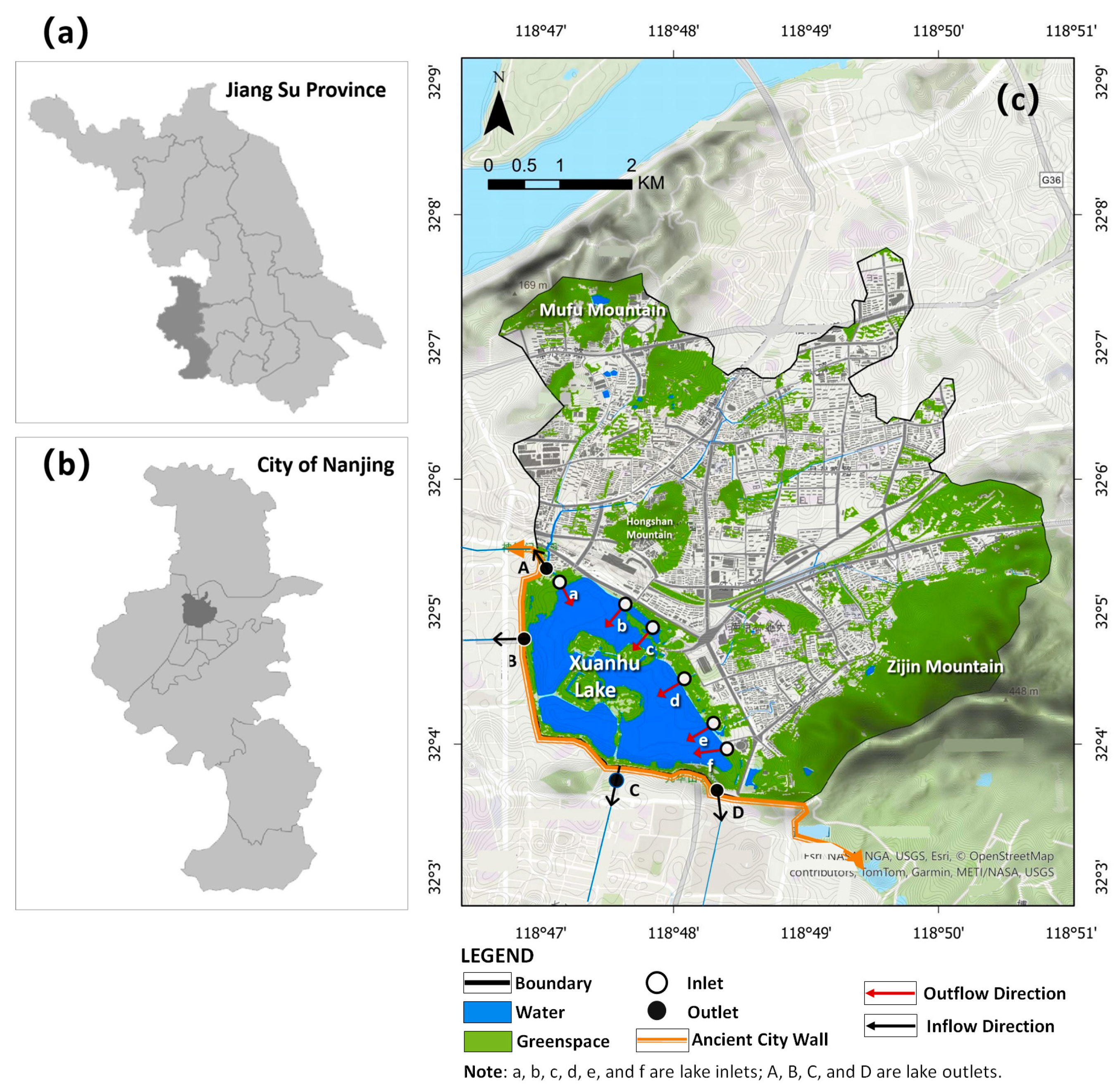
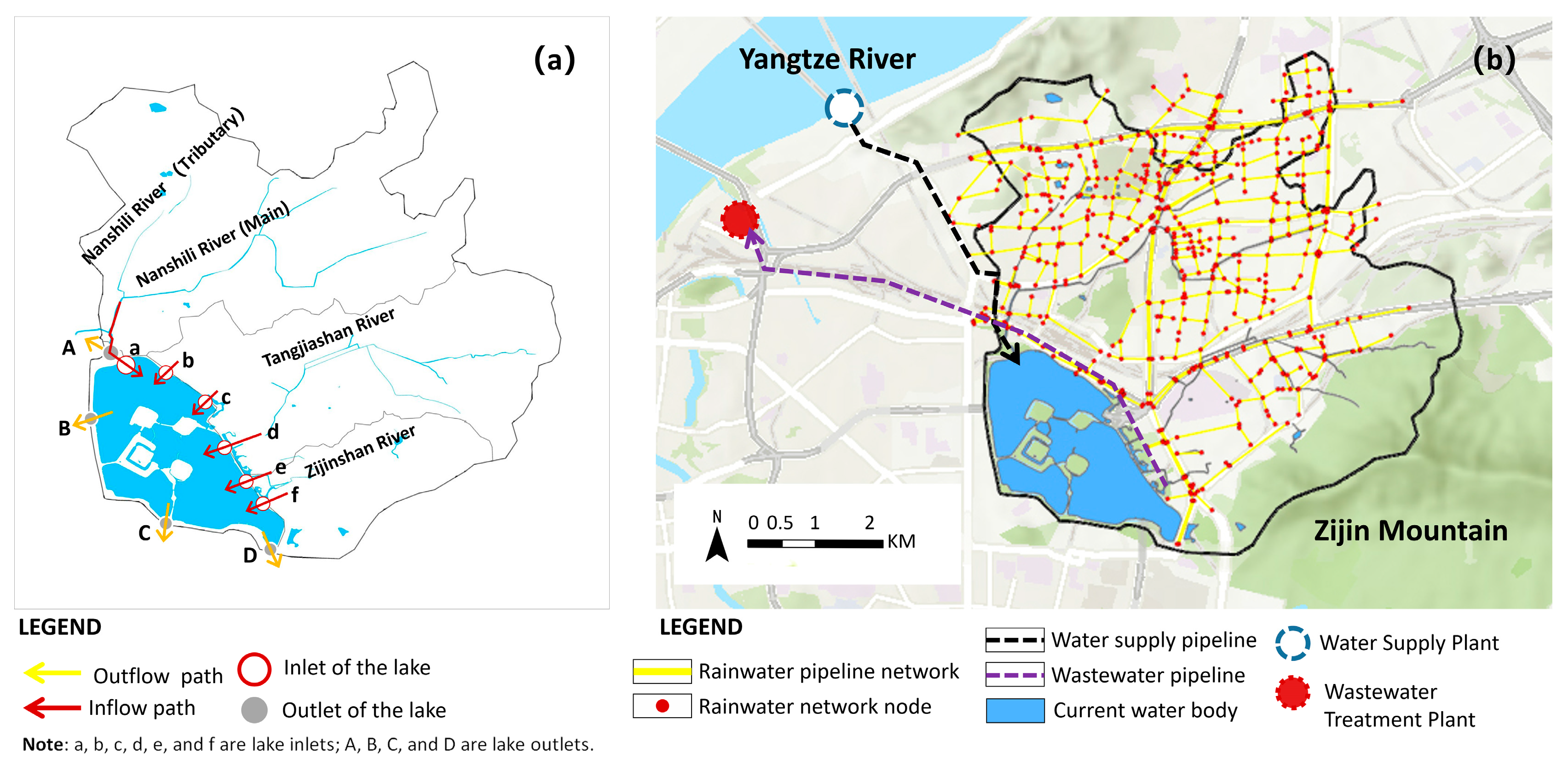
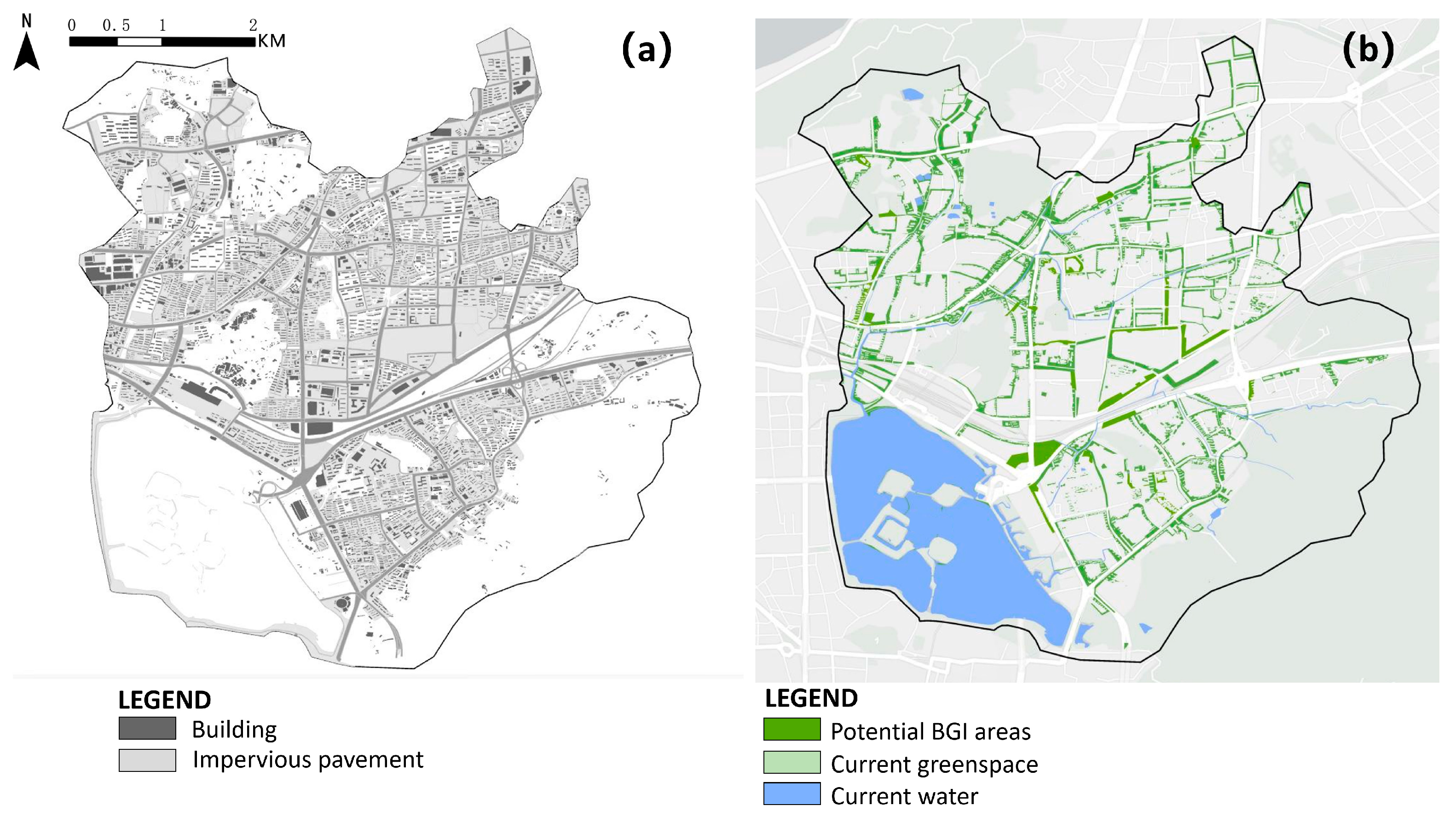
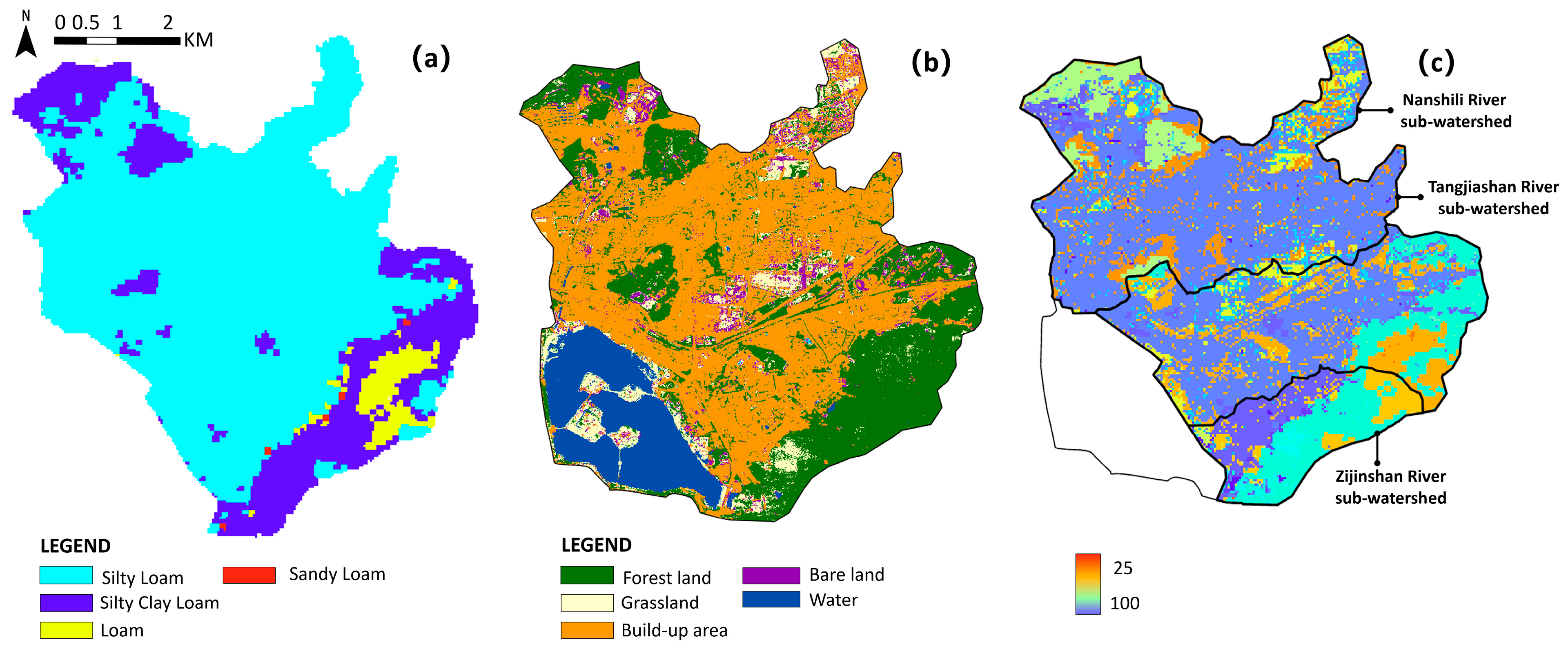
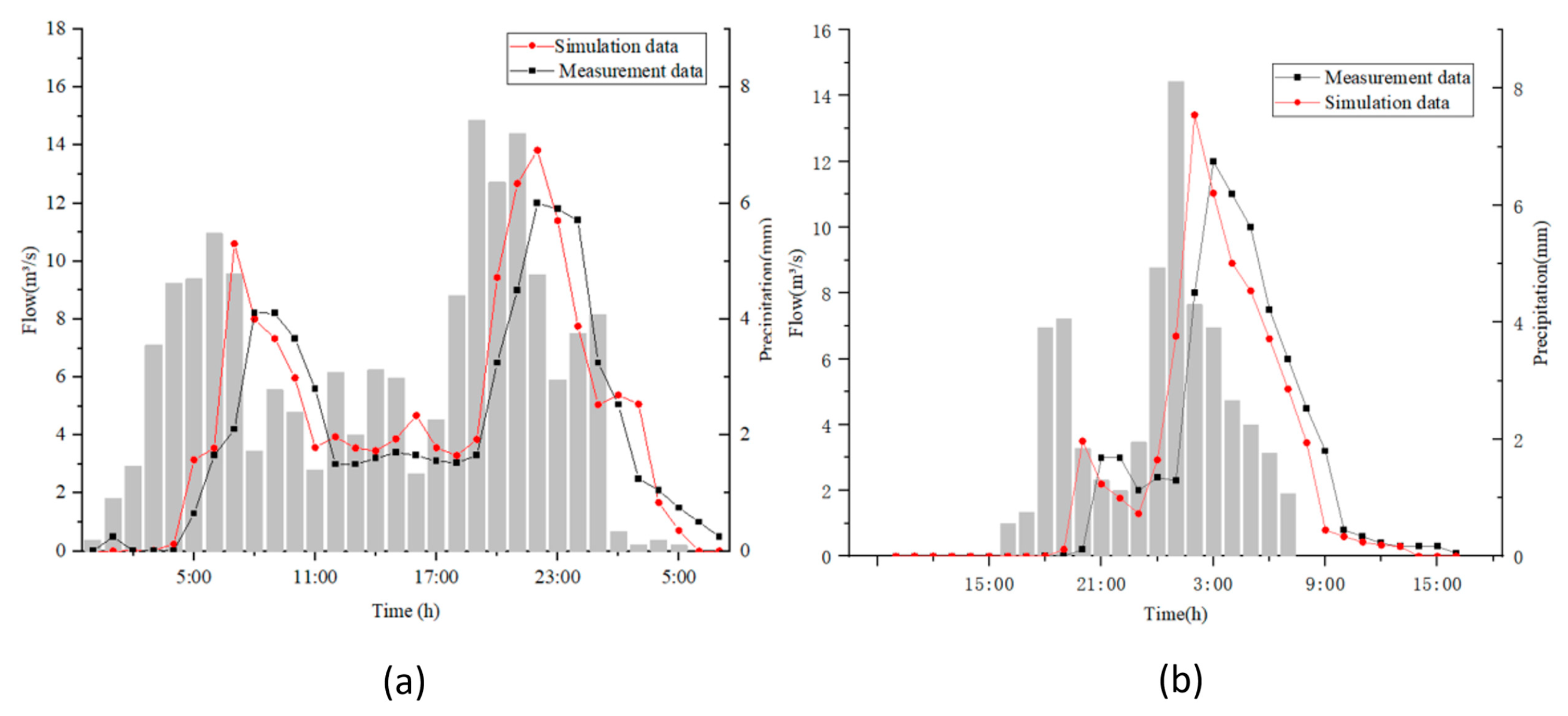
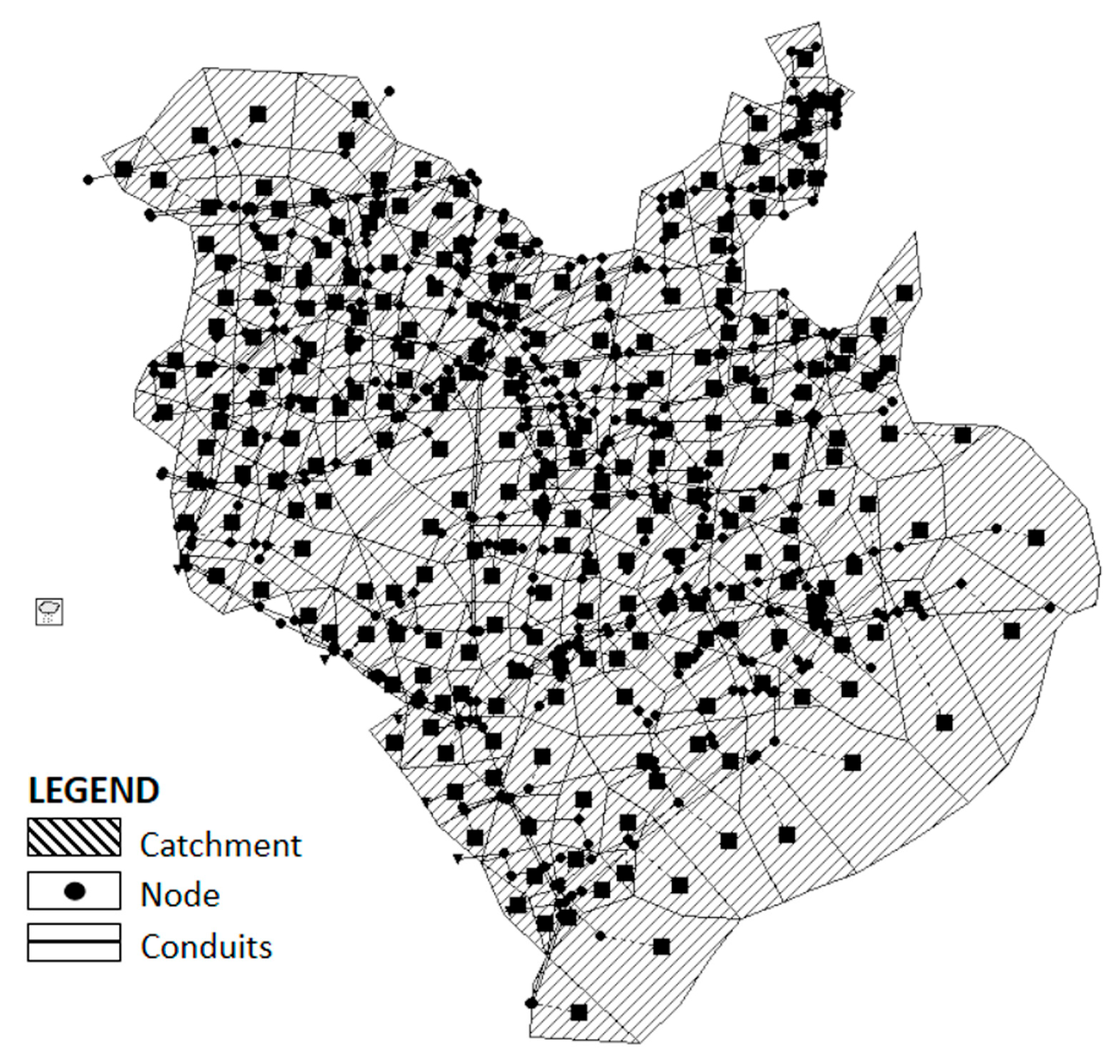

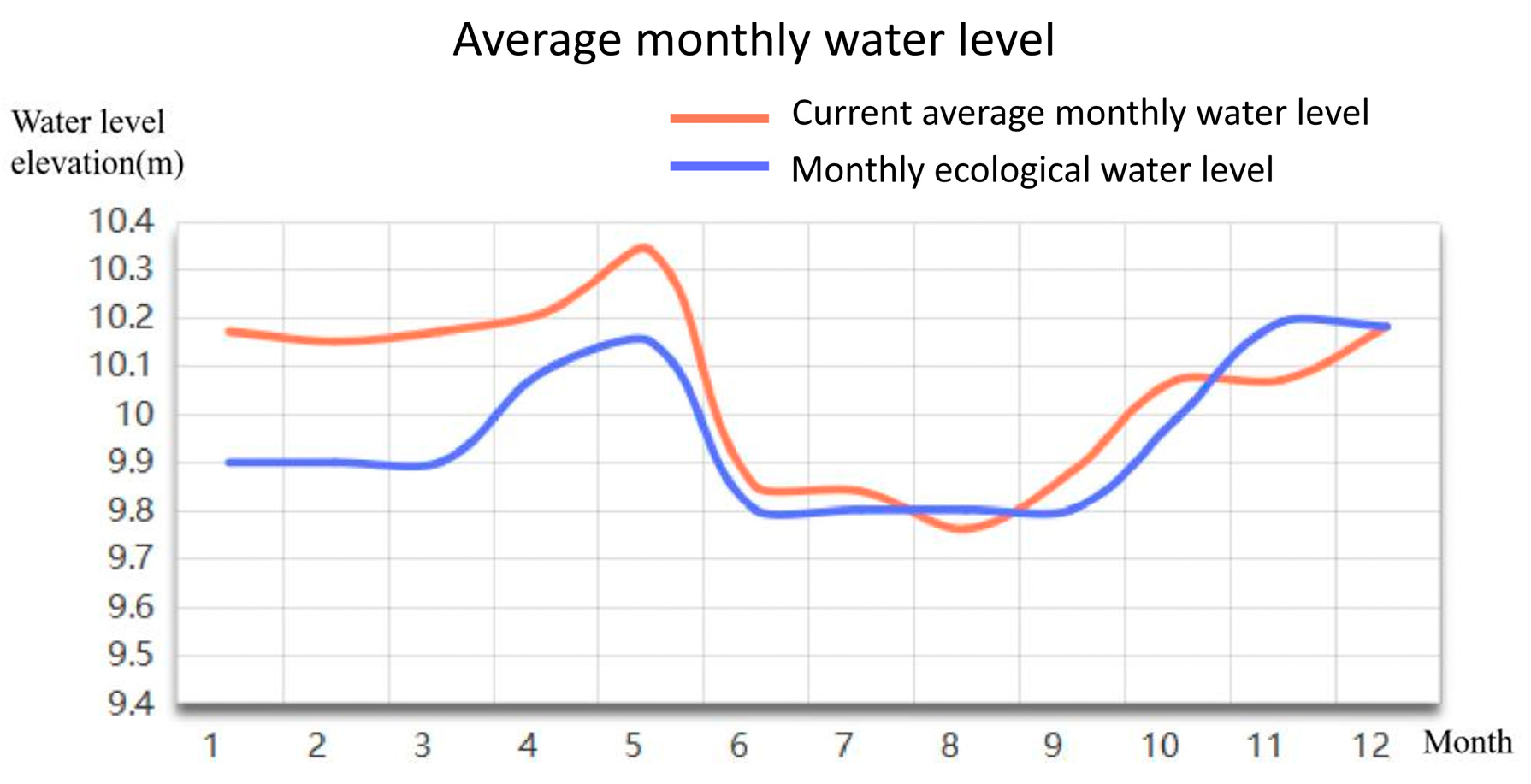
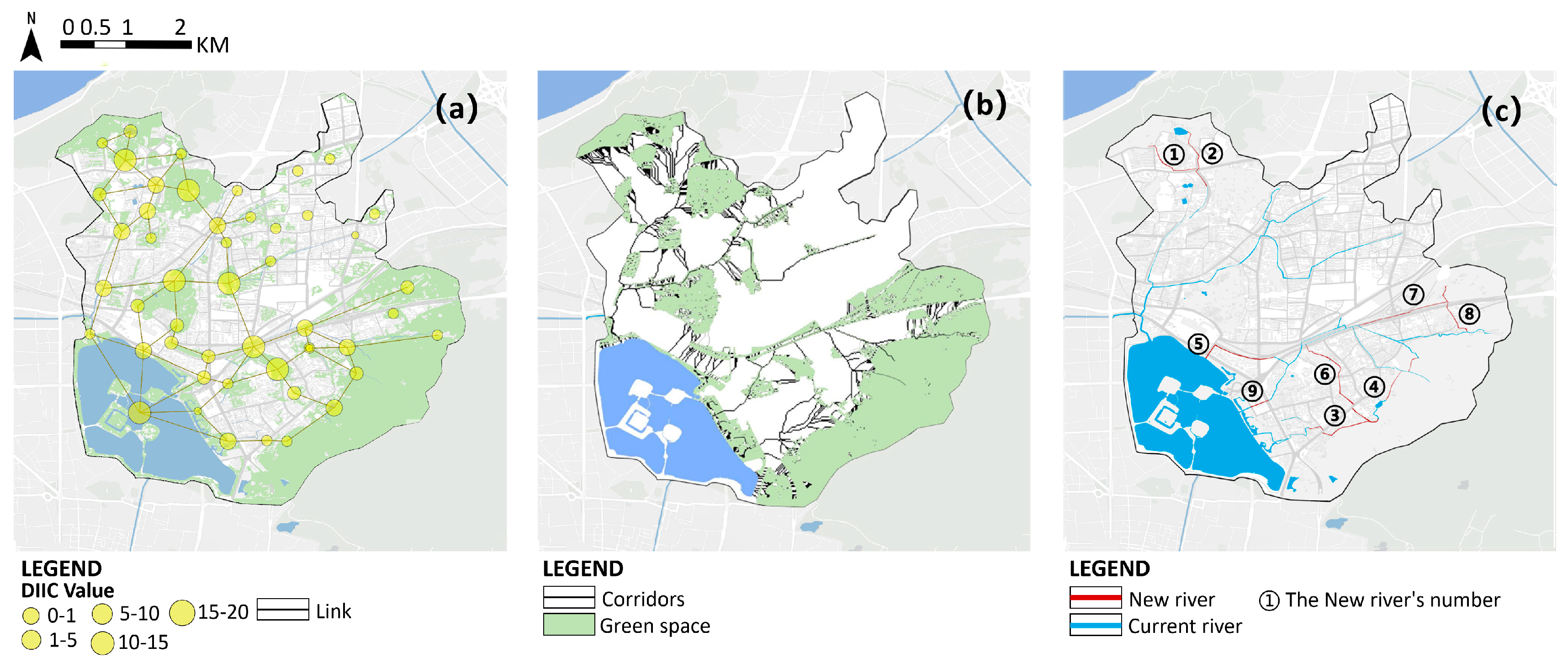

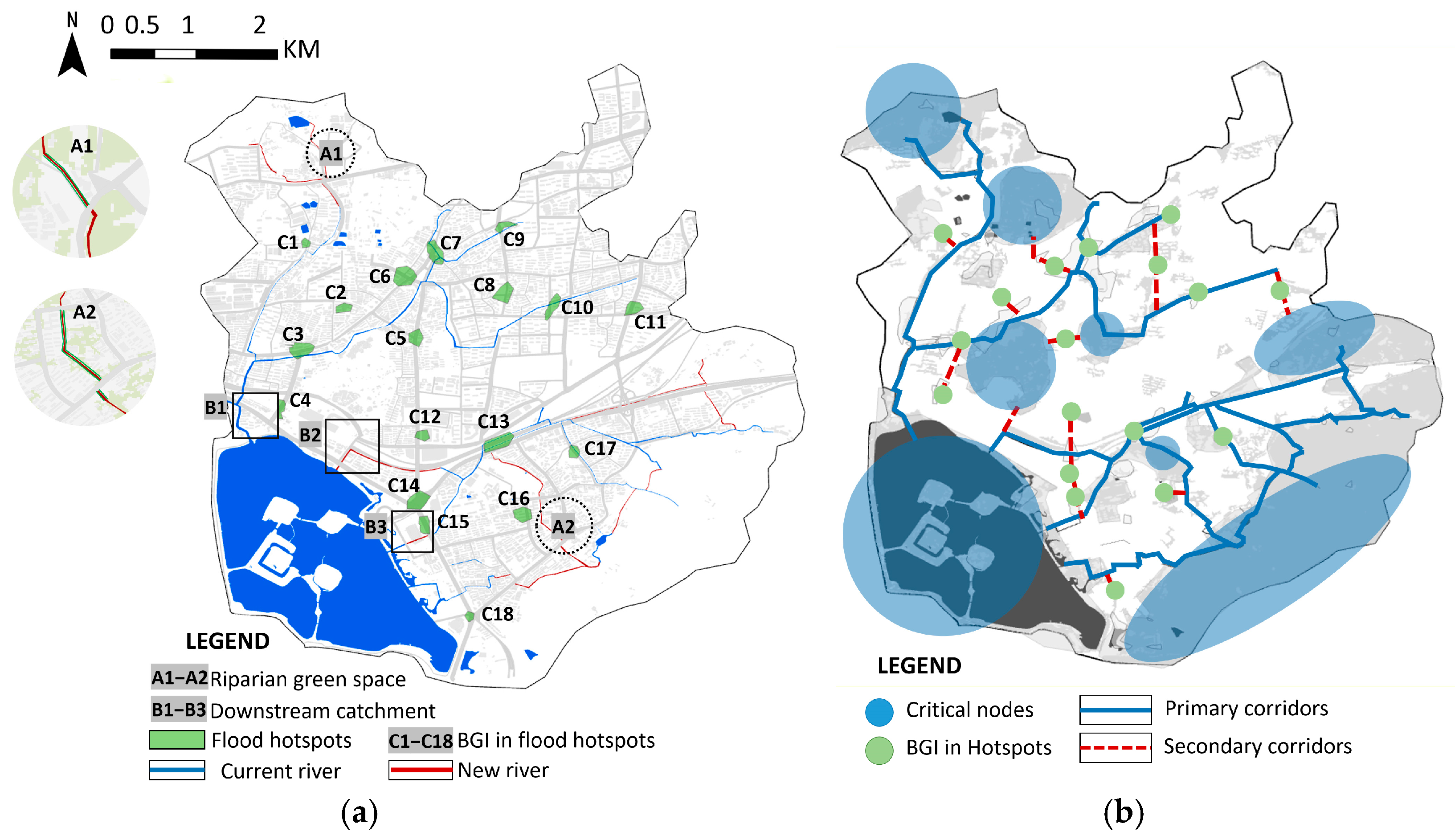
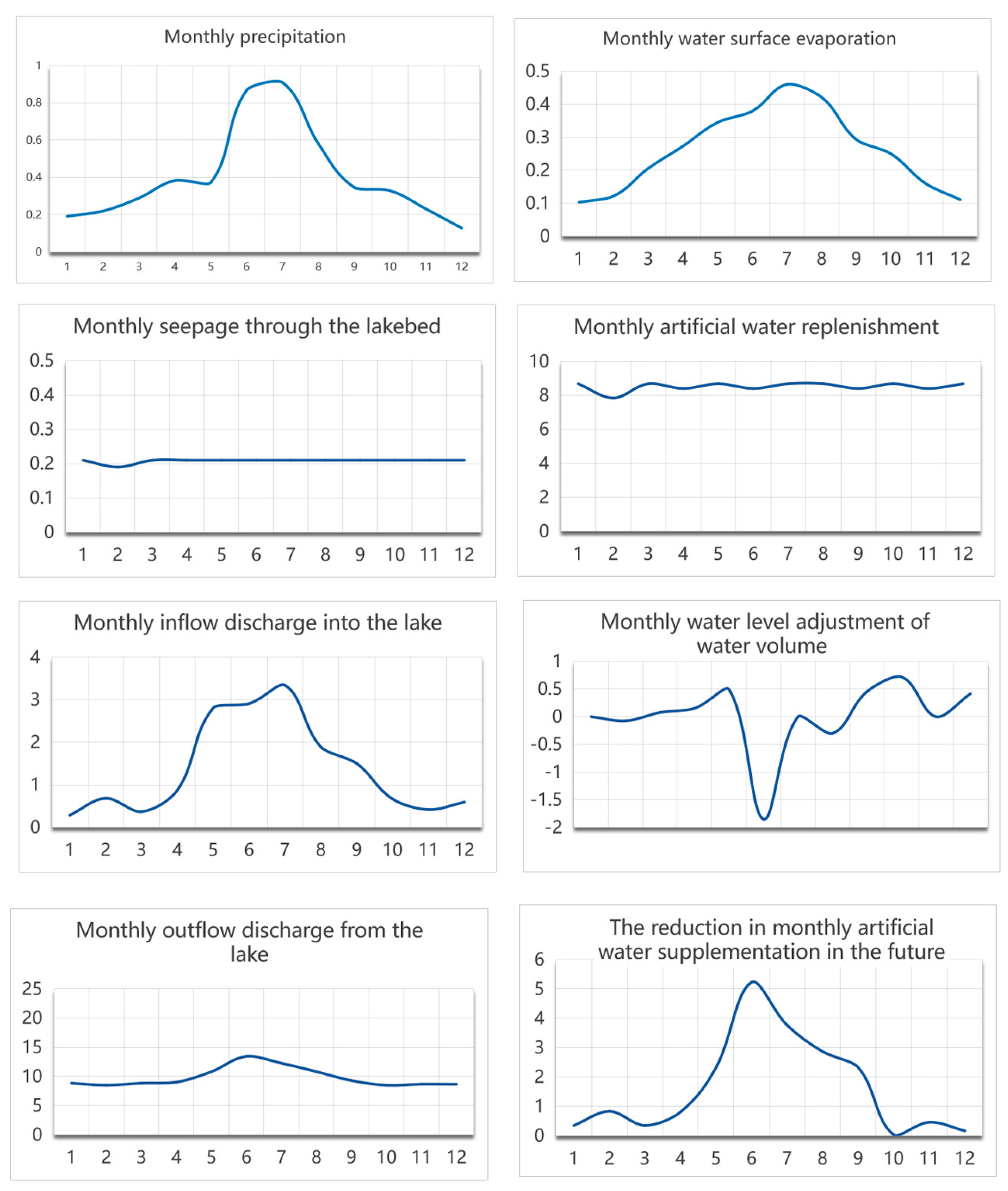
| Data Type | Scale/Format | Source |
|---|---|---|
| Digital elevation model | 12.5 m resolution | ALOS satellite |
| Green space, water system, roads, buildings | Electronic map, vector data | Google Maps (2023) |
| Hourly rainfall data | Spreadsheet | National meteorological science data center; Meteorological station data (2023) https://data.cma.cn/site/index.html (accessed on 15 May 2024) Small weather station (12–13 July 2024; 16–17 September 2024). |
| Evaporation volume | Spreadsheet | ERA5 evaporation dataset |
| Lake water level data; artificial water supplementation data; lakebed seepage coefficient data | Text | Literature review |
| Land use data | 1 m resolution | SinoLC–1 (2023), Zenodo http://www.ncdc.ac.cn (accessed on 16 May 2024) |
| Soil texture data | 90 m | High-resolution national soil information grid basic attribute dataset of China https://soil.geodata.cn (accessed on 3 June 2025). |
| Rainwater drainage network data | Vector data | Nanjing water bureau |
| Comprehensive Drainage and Flood Control Planning for the Central Urban Area of Nanjing City; The Sponge City Construction Plan of Nanjing City | Text | Nanjing natural resources and planning bureau |
| River flow data | Measurement data | Field Measurements (2024) |
| Local waterlogging points | Vector data | Depressions extracted from DEM using ArcGIS, webcrawler data, planning and literature data |
| Soil Hydrology Group | Soil Texture | Minimum Permeability (nm/h) |
|---|---|---|
| A | Sand, loamy sand, or sandy loam | 7.26–11.43 |
| B | Silt loam or loam | 3.81–7.26 |
| C | Sandy clay loam | 1.27–3.81 |
| D | Clay loam, silty clay loam, sandy clay, silty clay, or clay | 0–1.27 |
| Region | Land Use | A | B | C | D |
|---|---|---|---|---|---|
| Nanshili and Tangjiashan River sub-watersheds | Forest land | 25 | 49 | 70 | 77 |
| Grassland | 39 | 61 | 74 | 80 | |
| Bare land | 72 | 82 | 88 | 90 | |
| Water | 100 | 100 | 100 | 100 | |
| Built-up area | 89 | 91 | 94 | 96 | |
| Zijinshan River sub-watershed | Forest land | 27 | 51 | 72 | 79 |
| Grassland | 41 | 63 | 76 | 82 | |
| Bare land | 74 | 84 | 90 | 92 | |
| Water | 100 | 100 | 100 | 100 | |
| Built-up area | 91 | 93 | 96 | 98 |
| Parameter | Description | Reference Range | Calibrated Value |
|---|---|---|---|
| N–Imperv | Manning’s n for overland flow over the impervious portion of the sub-catchment | 0.011–0.024 | 0.015 |
| N–Perv | Manning’s n for overland flow over the pervious portion of the sub-catchment | 0.06–0.8 | 0.09 |
| S–Imperv | Depression storage for impervious areas | 0.2–10 | 2.5 |
| S–Perv | Depression storage for pervious areas | 2–20 | 6.5 |
| MaxRate | Maximum infiltration rate | 20–100 | 65.2 |
| MinRate | Minimum infiltration rate | 1–20 | 1.1 |
| Channel ID | Strategy | Channel Length (km) | Catchment Area (km2) | Catchment Area per Unit Length (km2/km) |
|---|---|---|---|---|
| 1 | Utilize existing green space | 1.336 | 0.841 | 0.63 |
| 2 | 300 m long, 1.8 m wide green belt | 1.074 | 1.192 | 1.17 |
| 3 | Utilize existing green space | 1.299 | 2.003 | 1.49 |
| 4 | Utilize existing green space | 1.216 | 2.076 | 1.46 |
| 5 | Utilize existing green space | 1.290 | 0.688 | 0.52 |
| 6 | 400 m long, 4 m wide green belte | 2.196 | 0.60 | 0.31 |
| 7 | Utilize existing green space | 1.511 | 1.741 | 1.15 |
| 8 | Utilize existing green space | 0.935 | 0.767 | 0.76 |
| 9 | Utilize existing green space | 0.327 | 0.363 | 1.13 |
| Month | 1 | 2 | 3 | 4 | 5 | 6 | 7 | 8 | 9 | 10 | 11 | 12 |
|---|---|---|---|---|---|---|---|---|---|---|---|---|
| Reduction Rate (%) | 4.0 | 10.6 | 4.0 | 9.6 | 26.7 | 62.2 | 43.4 | 33.0 | 27.7 | 0.04 | 5.5 | 4.0 |
Disclaimer/Publisher’s Note: The statements, opinions and data contained in all publications are solely those of the individual author(s) and contributor(s) and not of MDPI and/or the editor(s). MDPI and/or the editor(s) disclaim responsibility for any injury to people or property resulting from any ideas, methods, instructions or products referred to in the content. |
© 2025 by the authors. Licensee MDPI, Basel, Switzerland. This article is an open access article distributed under the terms and conditions of the Creative Commons Attribution (CC BY) license (https://creativecommons.org/licenses/by/4.0/).
Share and Cite
Chen, X.; Wang, X. Blue–Green Infrastructure Network Planning in Urban Small Watersheds Based on Water Balance. Land 2025, 14, 1652. https://doi.org/10.3390/land14081652
Chen X, Wang X. Blue–Green Infrastructure Network Planning in Urban Small Watersheds Based on Water Balance. Land. 2025; 14(8):1652. https://doi.org/10.3390/land14081652
Chicago/Turabian StyleChen, Xin, and Xiaojun Wang. 2025. "Blue–Green Infrastructure Network Planning in Urban Small Watersheds Based on Water Balance" Land 14, no. 8: 1652. https://doi.org/10.3390/land14081652
APA StyleChen, X., & Wang, X. (2025). Blue–Green Infrastructure Network Planning in Urban Small Watersheds Based on Water Balance. Land, 14(8), 1652. https://doi.org/10.3390/land14081652





